Assessing and Facilitating Warehouse Safety: A Case Study Approach
VerifiedAdded on 2023/04/21
|17
|4626
|349
Report
AI Summary
This paper assesses and facilitates warehouse safety, crucial for both employees and firms, addressing the significant global issue of workplace accidents. It reviews literature on logistics-based safety, focusing on factors like hazard reduction and transformational leadership, and discusses the importance of safety culture and behavior within warehouses. The methodology employs a case study approach, utilizing interviews within a Dutch LSP to explore warehouse activities and safety histories. The research identifies findings and limitations, offering practical implications and emphasizing the originality of the work in improving warehouse safety through comprehensive assessment and facilitation strategies. Desklib provides access to this and many other solved assignments to help students in their academic journey.
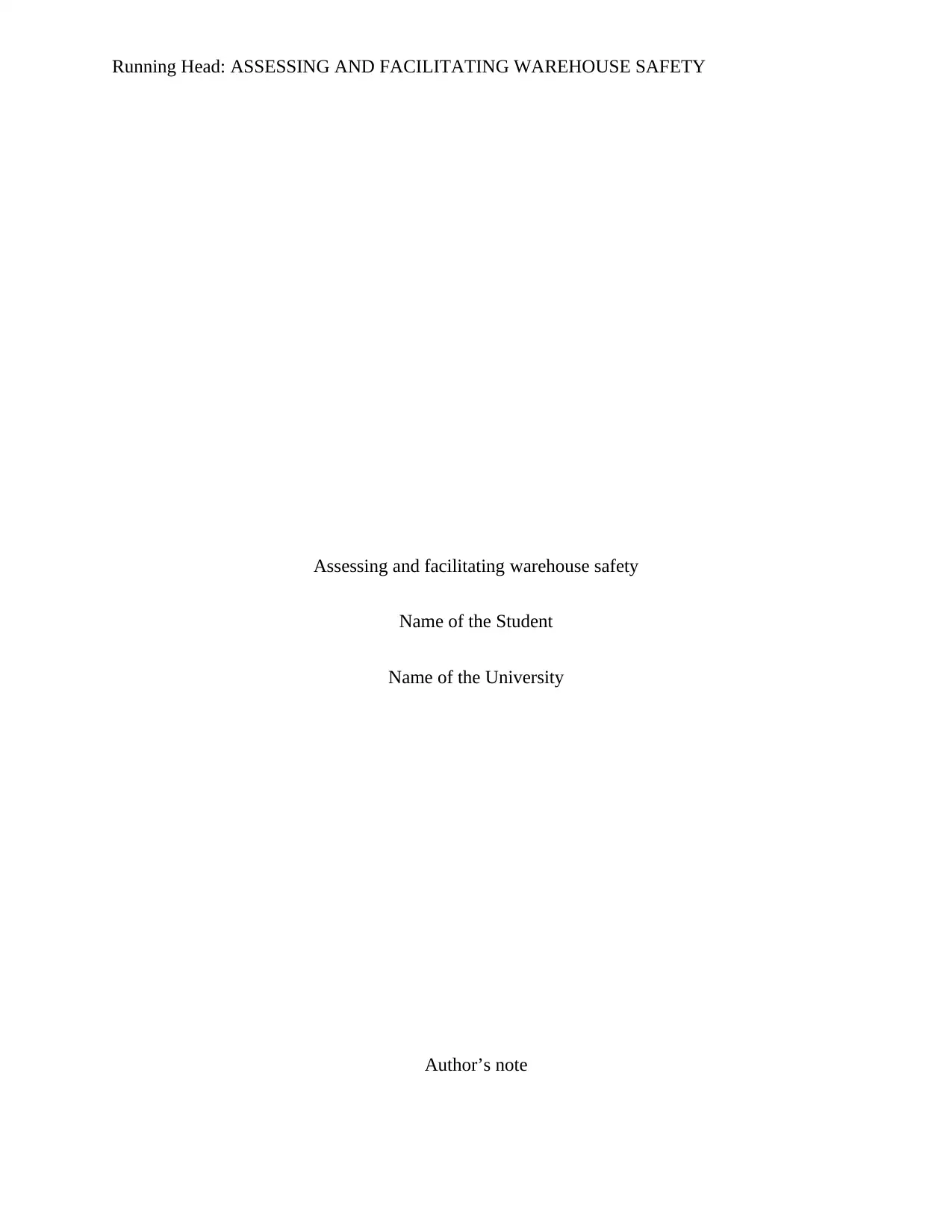
Running Head: ASSESSING AND FACILITATING WAREHOUSE SAFETY
Assessing and facilitating warehouse safety
Name of the Student
Name of the University
Author’s note
Assessing and facilitating warehouse safety
Name of the Student
Name of the University
Author’s note
Paraphrase This Document
Need a fresh take? Get an instant paraphrase of this document with our AI Paraphraser
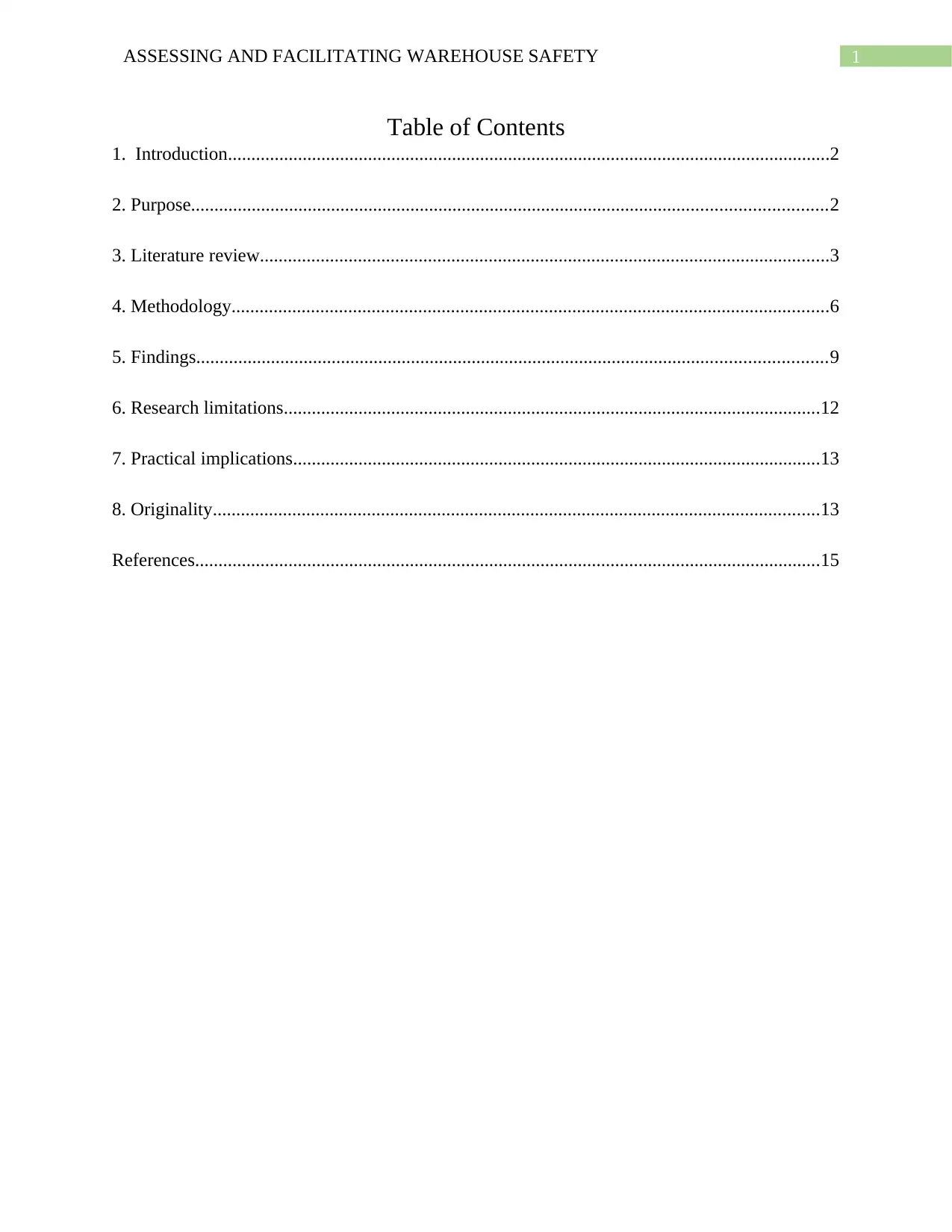
1ASSESSING AND FACILITATING WAREHOUSE SAFETY
Table of Contents
1. Introduction.................................................................................................................................2
2. Purpose........................................................................................................................................2
3. Literature review..........................................................................................................................3
4. Methodology................................................................................................................................6
5. Findings.......................................................................................................................................9
6. Research limitations...................................................................................................................12
7. Practical implications.................................................................................................................13
8. Originality..................................................................................................................................13
References......................................................................................................................................15
Table of Contents
1. Introduction.................................................................................................................................2
2. Purpose........................................................................................................................................2
3. Literature review..........................................................................................................................3
4. Methodology................................................................................................................................6
5. Findings.......................................................................................................................................9
6. Research limitations...................................................................................................................12
7. Practical implications.................................................................................................................13
8. Originality..................................................................................................................................13
References......................................................................................................................................15
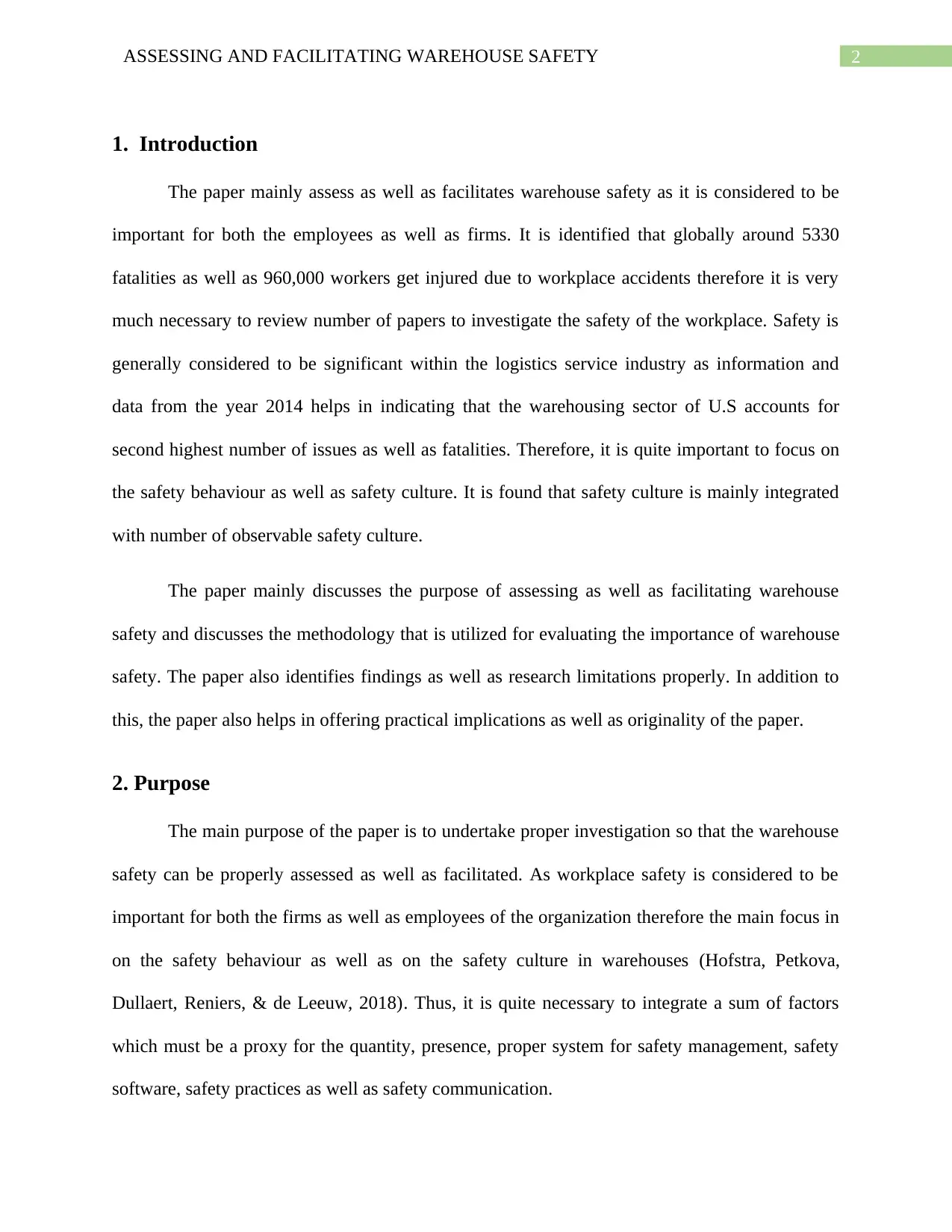
2ASSESSING AND FACILITATING WAREHOUSE SAFETY
1. Introduction
The paper mainly assess as well as facilitates warehouse safety as it is considered to be
important for both the employees as well as firms. It is identified that globally around 5330
fatalities as well as 960,000 workers get injured due to workplace accidents therefore it is very
much necessary to review number of papers to investigate the safety of the workplace. Safety is
generally considered to be significant within the logistics service industry as information and
data from the year 2014 helps in indicating that the warehousing sector of U.S accounts for
second highest number of issues as well as fatalities. Therefore, it is quite important to focus on
the safety behaviour as well as safety culture. It is found that safety culture is mainly integrated
with number of observable safety culture.
The paper mainly discusses the purpose of assessing as well as facilitating warehouse
safety and discusses the methodology that is utilized for evaluating the importance of warehouse
safety. The paper also identifies findings as well as research limitations properly. In addition to
this, the paper also helps in offering practical implications as well as originality of the paper.
2. Purpose
The main purpose of the paper is to undertake proper investigation so that the warehouse
safety can be properly assessed as well as facilitated. As workplace safety is considered to be
important for both the firms as well as employees of the organization therefore the main focus in
on the safety behaviour as well as on the safety culture in warehouses (Hofstra, Petkova,
Dullaert, Reniers, & de Leeuw, 2018). Thus, it is quite necessary to integrate a sum of factors
which must be a proxy for the quantity, presence, proper system for safety management, safety
software, safety practices as well as safety communication.
1. Introduction
The paper mainly assess as well as facilitates warehouse safety as it is considered to be
important for both the employees as well as firms. It is identified that globally around 5330
fatalities as well as 960,000 workers get injured due to workplace accidents therefore it is very
much necessary to review number of papers to investigate the safety of the workplace. Safety is
generally considered to be significant within the logistics service industry as information and
data from the year 2014 helps in indicating that the warehousing sector of U.S accounts for
second highest number of issues as well as fatalities. Therefore, it is quite important to focus on
the safety behaviour as well as safety culture. It is found that safety culture is mainly integrated
with number of observable safety culture.
The paper mainly discusses the purpose of assessing as well as facilitating warehouse
safety and discusses the methodology that is utilized for evaluating the importance of warehouse
safety. The paper also identifies findings as well as research limitations properly. In addition to
this, the paper also helps in offering practical implications as well as originality of the paper.
2. Purpose
The main purpose of the paper is to undertake proper investigation so that the warehouse
safety can be properly assessed as well as facilitated. As workplace safety is considered to be
important for both the firms as well as employees of the organization therefore the main focus in
on the safety behaviour as well as on the safety culture in warehouses (Hofstra, Petkova,
Dullaert, Reniers, & de Leeuw, 2018). Thus, it is quite necessary to integrate a sum of factors
which must be a proxy for the quantity, presence, proper system for safety management, safety
software, safety practices as well as safety communication.
⊘ This is a preview!⊘
Do you want full access?
Subscribe today to unlock all pages.

Trusted by 1+ million students worldwide
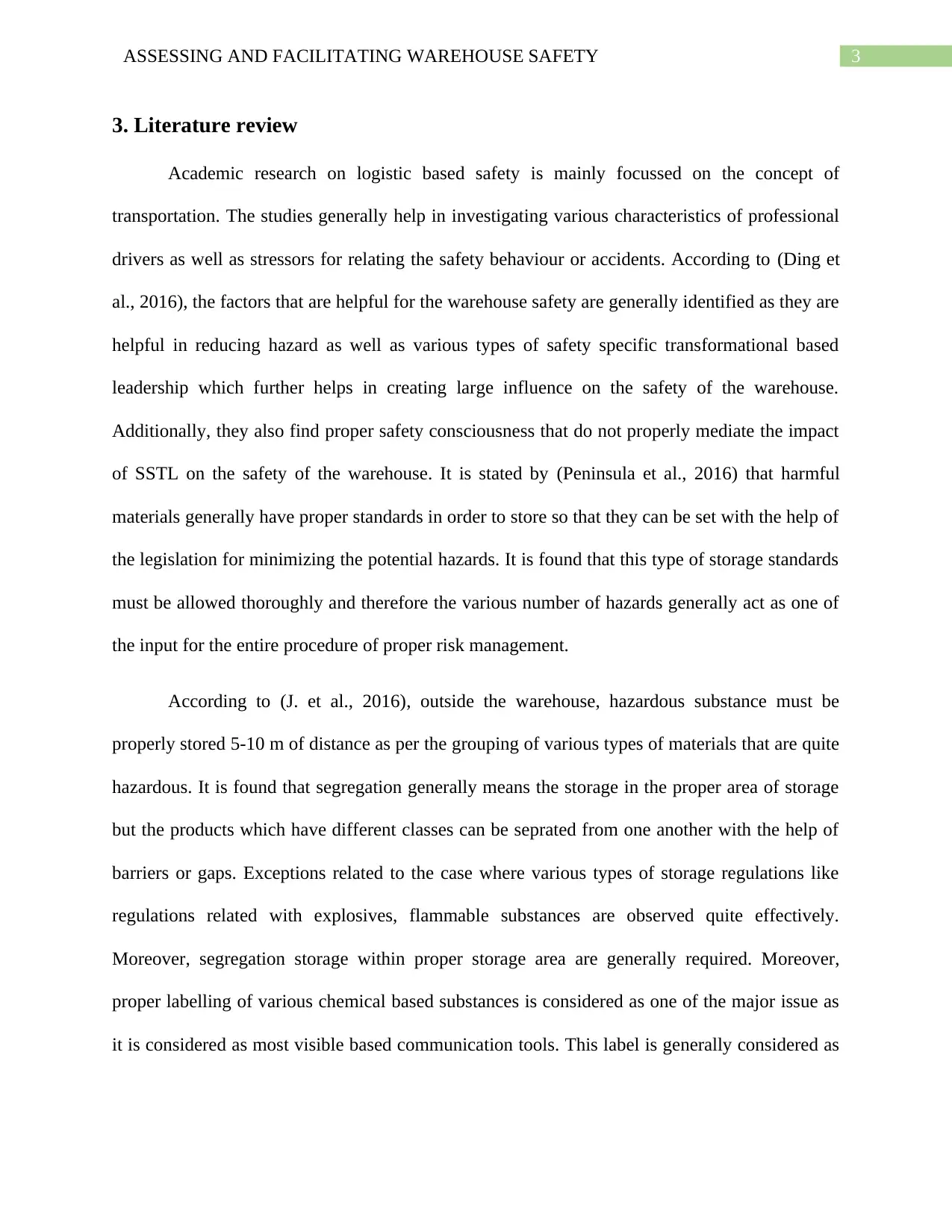
3ASSESSING AND FACILITATING WAREHOUSE SAFETY
3. Literature review
Academic research on logistic based safety is mainly focussed on the concept of
transportation. The studies generally help in investigating various characteristics of professional
drivers as well as stressors for relating the safety behaviour or accidents. According to (Ding et
al., 2016), the factors that are helpful for the warehouse safety are generally identified as they are
helpful in reducing hazard as well as various types of safety specific transformational based
leadership which further helps in creating large influence on the safety of the warehouse.
Additionally, they also find proper safety consciousness that do not properly mediate the impact
of SSTL on the safety of the warehouse. It is stated by (Peninsula et al., 2016) that harmful
materials generally have proper standards in order to store so that they can be set with the help of
the legislation for minimizing the potential hazards. It is found that this type of storage standards
must be allowed thoroughly and therefore the various number of hazards generally act as one of
the input for the entire procedure of proper risk management.
According to (J. et al., 2016), outside the warehouse, hazardous substance must be
properly stored 5-10 m of distance as per the grouping of various types of materials that are quite
hazardous. It is found that segregation generally means the storage in the proper area of storage
but the products which have different classes can be seprated from one another with the help of
barriers or gaps. Exceptions related to the case where various types of storage regulations like
regulations related with explosives, flammable substances are observed quite effectively.
Moreover, segregation storage within proper storage area are generally required. Moreover,
proper labelling of various chemical based substances is considered as one of the major issue as
it is considered as most visible based communication tools. This label is generally considered as
3. Literature review
Academic research on logistic based safety is mainly focussed on the concept of
transportation. The studies generally help in investigating various characteristics of professional
drivers as well as stressors for relating the safety behaviour or accidents. According to (Ding et
al., 2016), the factors that are helpful for the warehouse safety are generally identified as they are
helpful in reducing hazard as well as various types of safety specific transformational based
leadership which further helps in creating large influence on the safety of the warehouse.
Additionally, they also find proper safety consciousness that do not properly mediate the impact
of SSTL on the safety of the warehouse. It is stated by (Peninsula et al., 2016) that harmful
materials generally have proper standards in order to store so that they can be set with the help of
the legislation for minimizing the potential hazards. It is found that this type of storage standards
must be allowed thoroughly and therefore the various number of hazards generally act as one of
the input for the entire procedure of proper risk management.
According to (J. et al., 2016), outside the warehouse, hazardous substance must be
properly stored 5-10 m of distance as per the grouping of various types of materials that are quite
hazardous. It is found that segregation generally means the storage in the proper area of storage
but the products which have different classes can be seprated from one another with the help of
barriers or gaps. Exceptions related to the case where various types of storage regulations like
regulations related with explosives, flammable substances are observed quite effectively.
Moreover, segregation storage within proper storage area are generally required. Moreover,
proper labelling of various chemical based substances is considered as one of the major issue as
it is considered as most visible based communication tools. This label is generally considered as
Paraphrase This Document
Need a fresh take? Get an instant paraphrase of this document with our AI Paraphraser
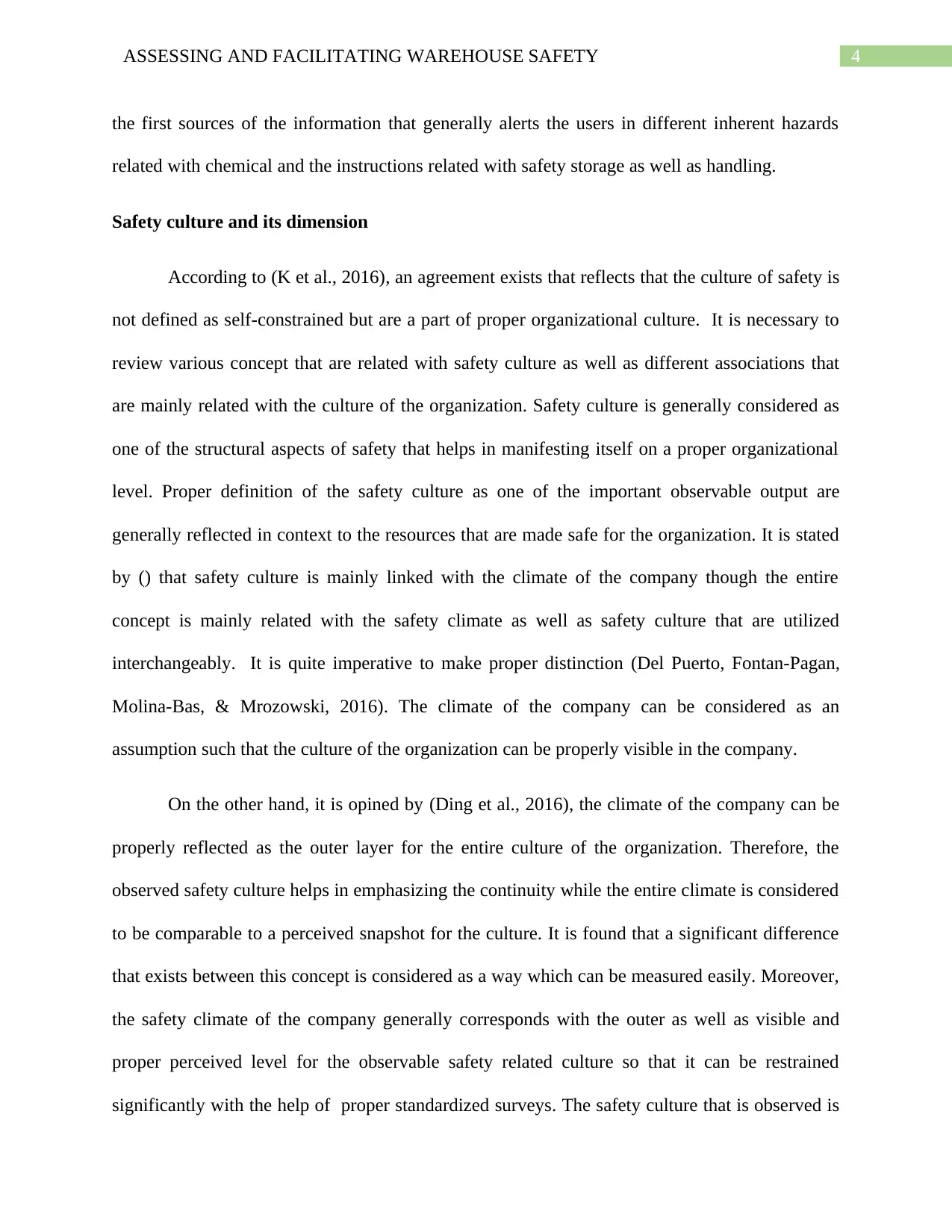
4ASSESSING AND FACILITATING WAREHOUSE SAFETY
the first sources of the information that generally alerts the users in different inherent hazards
related with chemical and the instructions related with safety storage as well as handling.
Safety culture and its dimension
According to (K et al., 2016), an agreement exists that reflects that the culture of safety is
not defined as self-constrained but are a part of proper organizational culture. It is necessary to
review various concept that are related with safety culture as well as different associations that
are mainly related with the culture of the organization. Safety culture is generally considered as
one of the structural aspects of safety that helps in manifesting itself on a proper organizational
level. Proper definition of the safety culture as one of the important observable output are
generally reflected in context to the resources that are made safe for the organization. It is stated
by () that safety culture is mainly linked with the climate of the company though the entire
concept is mainly related with the safety climate as well as safety culture that are utilized
interchangeably. It is quite imperative to make proper distinction (Del Puerto, Fontan-Pagan,
Molina-Bas, & Mrozowski, 2016). The climate of the company can be considered as an
assumption such that the culture of the organization can be properly visible in the company.
On the other hand, it is opined by (Ding et al., 2016), the climate of the company can be
properly reflected as the outer layer for the entire culture of the organization. Therefore, the
observed safety culture helps in emphasizing the continuity while the entire climate is considered
to be comparable to a perceived snapshot for the culture. It is found that a significant difference
that exists between this concept is considered as a way which can be measured easily. Moreover,
the safety climate of the company generally corresponds with the outer as well as visible and
proper perceived level for the observable safety related culture so that it can be restrained
significantly with the help of proper standardized surveys. The safety culture that is observed is
the first sources of the information that generally alerts the users in different inherent hazards
related with chemical and the instructions related with safety storage as well as handling.
Safety culture and its dimension
According to (K et al., 2016), an agreement exists that reflects that the culture of safety is
not defined as self-constrained but are a part of proper organizational culture. It is necessary to
review various concept that are related with safety culture as well as different associations that
are mainly related with the culture of the organization. Safety culture is generally considered as
one of the structural aspects of safety that helps in manifesting itself on a proper organizational
level. Proper definition of the safety culture as one of the important observable output are
generally reflected in context to the resources that are made safe for the organization. It is stated
by () that safety culture is mainly linked with the climate of the company though the entire
concept is mainly related with the safety climate as well as safety culture that are utilized
interchangeably. It is quite imperative to make proper distinction (Del Puerto, Fontan-Pagan,
Molina-Bas, & Mrozowski, 2016). The climate of the company can be considered as an
assumption such that the culture of the organization can be properly visible in the company.
On the other hand, it is opined by (Ding et al., 2016), the climate of the company can be
properly reflected as the outer layer for the entire culture of the organization. Therefore, the
observed safety culture helps in emphasizing the continuity while the entire climate is considered
to be comparable to a perceived snapshot for the culture. It is found that a significant difference
that exists between this concept is considered as a way which can be measured easily. Moreover,
the safety climate of the company generally corresponds with the outer as well as visible and
proper perceived level for the observable safety related culture so that it can be restrained
significantly with the help of proper standardized surveys. The safety culture that is observed is
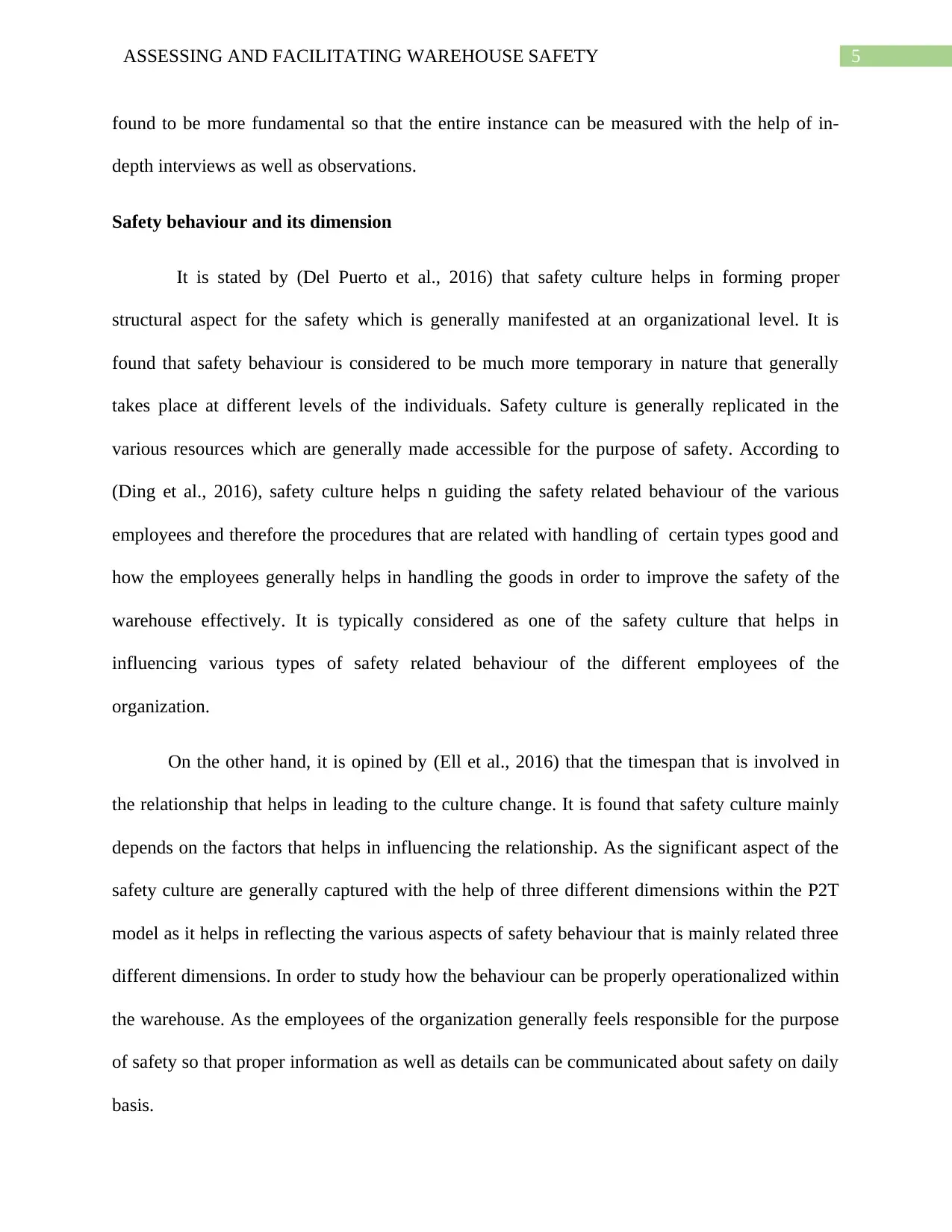
5ASSESSING AND FACILITATING WAREHOUSE SAFETY
found to be more fundamental so that the entire instance can be measured with the help of in-
depth interviews as well as observations.
Safety behaviour and its dimension
It is stated by (Del Puerto et al., 2016) that safety culture helps in forming proper
structural aspect for the safety which is generally manifested at an organizational level. It is
found that safety behaviour is considered to be much more temporary in nature that generally
takes place at different levels of the individuals. Safety culture is generally replicated in the
various resources which are generally made accessible for the purpose of safety. According to
(Ding et al., 2016), safety culture helps n guiding the safety related behaviour of the various
employees and therefore the procedures that are related with handling of certain types good and
how the employees generally helps in handling the goods in order to improve the safety of the
warehouse effectively. It is typically considered as one of the safety culture that helps in
influencing various types of safety related behaviour of the different employees of the
organization.
On the other hand, it is opined by (Ell et al., 2016) that the timespan that is involved in
the relationship that helps in leading to the culture change. It is found that safety culture mainly
depends on the factors that helps in influencing the relationship. As the significant aspect of the
safety culture are generally captured with the help of three different dimensions within the P2T
model as it helps in reflecting the various aspects of safety behaviour that is mainly related three
different dimensions. In order to study how the behaviour can be properly operationalized within
the warehouse. As the employees of the organization generally feels responsible for the purpose
of safety so that proper information as well as details can be communicated about safety on daily
basis.
found to be more fundamental so that the entire instance can be measured with the help of in-
depth interviews as well as observations.
Safety behaviour and its dimension
It is stated by (Del Puerto et al., 2016) that safety culture helps in forming proper
structural aspect for the safety which is generally manifested at an organizational level. It is
found that safety behaviour is considered to be much more temporary in nature that generally
takes place at different levels of the individuals. Safety culture is generally replicated in the
various resources which are generally made accessible for the purpose of safety. According to
(Ding et al., 2016), safety culture helps n guiding the safety related behaviour of the various
employees and therefore the procedures that are related with handling of certain types good and
how the employees generally helps in handling the goods in order to improve the safety of the
warehouse effectively. It is typically considered as one of the safety culture that helps in
influencing various types of safety related behaviour of the different employees of the
organization.
On the other hand, it is opined by (Ell et al., 2016) that the timespan that is involved in
the relationship that helps in leading to the culture change. It is found that safety culture mainly
depends on the factors that helps in influencing the relationship. As the significant aspect of the
safety culture are generally captured with the help of three different dimensions within the P2T
model as it helps in reflecting the various aspects of safety behaviour that is mainly related three
different dimensions. In order to study how the behaviour can be properly operationalized within
the warehouse. As the employees of the organization generally feels responsible for the purpose
of safety so that proper information as well as details can be communicated about safety on daily
basis.
⊘ This is a preview!⊘
Do you want full access?
Subscribe today to unlock all pages.

Trusted by 1+ million students worldwide
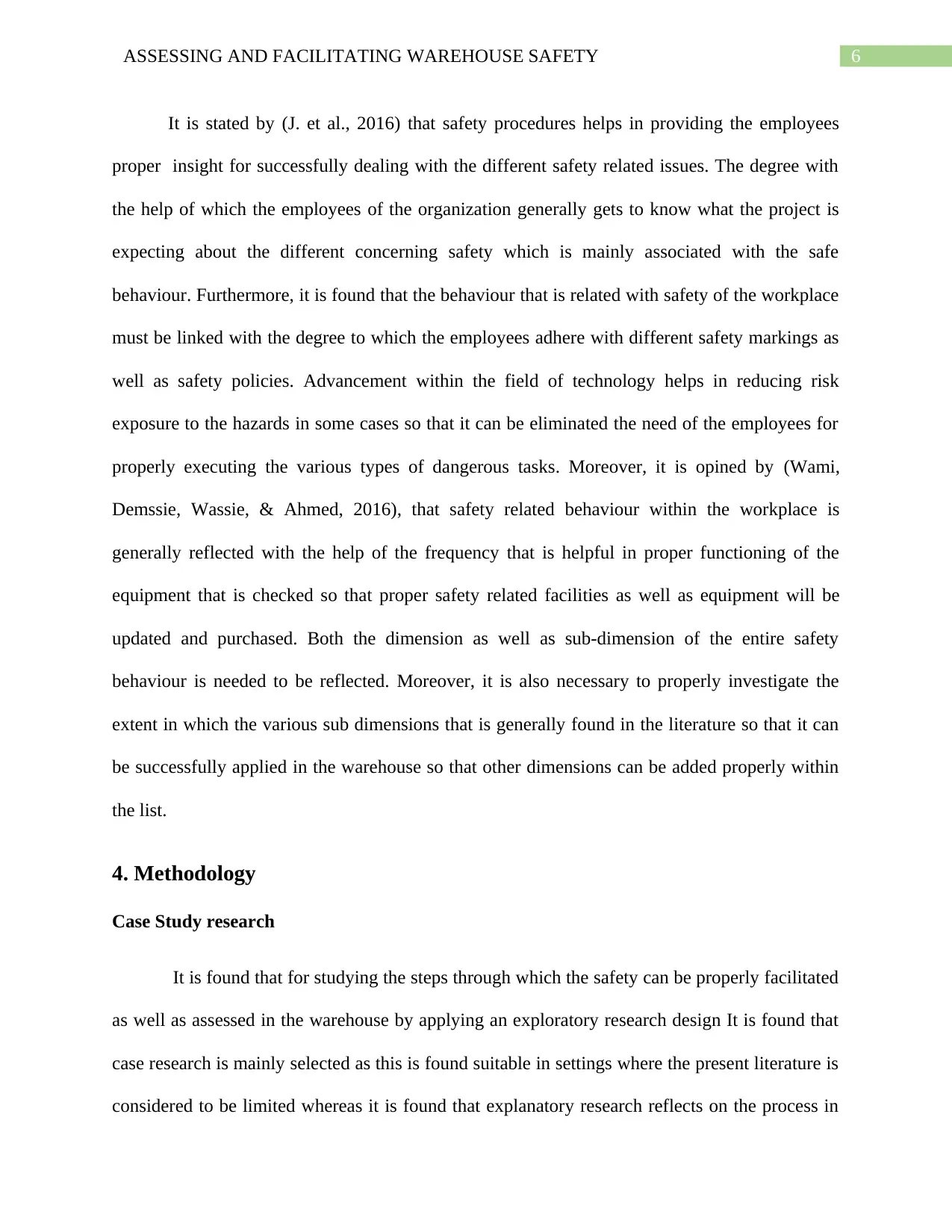
6ASSESSING AND FACILITATING WAREHOUSE SAFETY
It is stated by (J. et al., 2016) that safety procedures helps in providing the employees
proper insight for successfully dealing with the different safety related issues. The degree with
the help of which the employees of the organization generally gets to know what the project is
expecting about the different concerning safety which is mainly associated with the safe
behaviour. Furthermore, it is found that the behaviour that is related with safety of the workplace
must be linked with the degree to which the employees adhere with different safety markings as
well as safety policies. Advancement within the field of technology helps in reducing risk
exposure to the hazards in some cases so that it can be eliminated the need of the employees for
properly executing the various types of dangerous tasks. Moreover, it is opined by (Wami,
Demssie, Wassie, & Ahmed, 2016), that safety related behaviour within the workplace is
generally reflected with the help of the frequency that is helpful in proper functioning of the
equipment that is checked so that proper safety related facilities as well as equipment will be
updated and purchased. Both the dimension as well as sub-dimension of the entire safety
behaviour is needed to be reflected. Moreover, it is also necessary to properly investigate the
extent in which the various sub dimensions that is generally found in the literature so that it can
be successfully applied in the warehouse so that other dimensions can be added properly within
the list.
4. Methodology
Case Study research
It is found that for studying the steps through which the safety can be properly facilitated
as well as assessed in the warehouse by applying an exploratory research design It is found that
case research is mainly selected as this is found suitable in settings where the present literature is
considered to be limited whereas it is found that explanatory research reflects on the process in
It is stated by (J. et al., 2016) that safety procedures helps in providing the employees
proper insight for successfully dealing with the different safety related issues. The degree with
the help of which the employees of the organization generally gets to know what the project is
expecting about the different concerning safety which is mainly associated with the safe
behaviour. Furthermore, it is found that the behaviour that is related with safety of the workplace
must be linked with the degree to which the employees adhere with different safety markings as
well as safety policies. Advancement within the field of technology helps in reducing risk
exposure to the hazards in some cases so that it can be eliminated the need of the employees for
properly executing the various types of dangerous tasks. Moreover, it is opined by (Wami,
Demssie, Wassie, & Ahmed, 2016), that safety related behaviour within the workplace is
generally reflected with the help of the frequency that is helpful in proper functioning of the
equipment that is checked so that proper safety related facilities as well as equipment will be
updated and purchased. Both the dimension as well as sub-dimension of the entire safety
behaviour is needed to be reflected. Moreover, it is also necessary to properly investigate the
extent in which the various sub dimensions that is generally found in the literature so that it can
be successfully applied in the warehouse so that other dimensions can be added properly within
the list.
4. Methodology
Case Study research
It is found that for studying the steps through which the safety can be properly facilitated
as well as assessed in the warehouse by applying an exploratory research design It is found that
case research is mainly selected as this is found suitable in settings where the present literature is
considered to be limited whereas it is found that explanatory research reflects on the process in
Paraphrase This Document
Need a fresh take? Get an instant paraphrase of this document with our AI Paraphraser
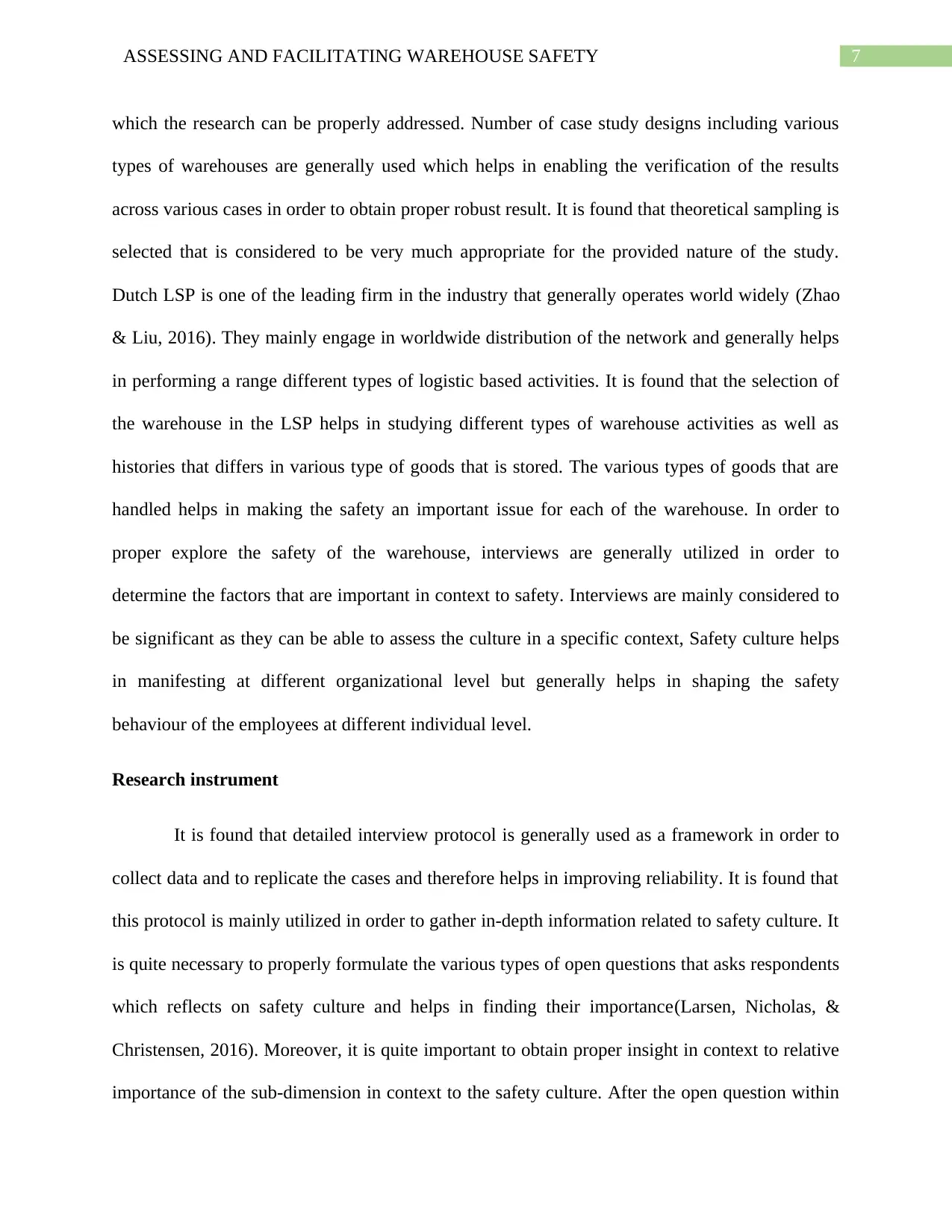
7ASSESSING AND FACILITATING WAREHOUSE SAFETY
which the research can be properly addressed. Number of case study designs including various
types of warehouses are generally used which helps in enabling the verification of the results
across various cases in order to obtain proper robust result. It is found that theoretical sampling is
selected that is considered to be very much appropriate for the provided nature of the study.
Dutch LSP is one of the leading firm in the industry that generally operates world widely (Zhao
& Liu, 2016). They mainly engage in worldwide distribution of the network and generally helps
in performing a range different types of logistic based activities. It is found that the selection of
the warehouse in the LSP helps in studying different types of warehouse activities as well as
histories that differs in various type of goods that is stored. The various types of goods that are
handled helps in making the safety an important issue for each of the warehouse. In order to
proper explore the safety of the warehouse, interviews are generally utilized in order to
determine the factors that are important in context to safety. Interviews are mainly considered to
be significant as they can be able to assess the culture in a specific context, Safety culture helps
in manifesting at different organizational level but generally helps in shaping the safety
behaviour of the employees at different individual level.
Research instrument
It is found that detailed interview protocol is generally used as a framework in order to
collect data and to replicate the cases and therefore helps in improving reliability. It is found that
this protocol is mainly utilized in order to gather in-depth information related to safety culture. It
is quite necessary to properly formulate the various types of open questions that asks respondents
which reflects on safety culture and helps in finding their importance(Larsen, Nicholas, &
Christensen, 2016). Moreover, it is quite important to obtain proper insight in context to relative
importance of the sub-dimension in context to the safety culture. After the open question within
which the research can be properly addressed. Number of case study designs including various
types of warehouses are generally used which helps in enabling the verification of the results
across various cases in order to obtain proper robust result. It is found that theoretical sampling is
selected that is considered to be very much appropriate for the provided nature of the study.
Dutch LSP is one of the leading firm in the industry that generally operates world widely (Zhao
& Liu, 2016). They mainly engage in worldwide distribution of the network and generally helps
in performing a range different types of logistic based activities. It is found that the selection of
the warehouse in the LSP helps in studying different types of warehouse activities as well as
histories that differs in various type of goods that is stored. The various types of goods that are
handled helps in making the safety an important issue for each of the warehouse. In order to
proper explore the safety of the warehouse, interviews are generally utilized in order to
determine the factors that are important in context to safety. Interviews are mainly considered to
be significant as they can be able to assess the culture in a specific context, Safety culture helps
in manifesting at different organizational level but generally helps in shaping the safety
behaviour of the employees at different individual level.
Research instrument
It is found that detailed interview protocol is generally used as a framework in order to
collect data and to replicate the cases and therefore helps in improving reliability. It is found that
this protocol is mainly utilized in order to gather in-depth information related to safety culture. It
is quite necessary to properly formulate the various types of open questions that asks respondents
which reflects on safety culture and helps in finding their importance(Larsen, Nicholas, &
Christensen, 2016). Moreover, it is quite important to obtain proper insight in context to relative
importance of the sub-dimension in context to the safety culture. After the open question within
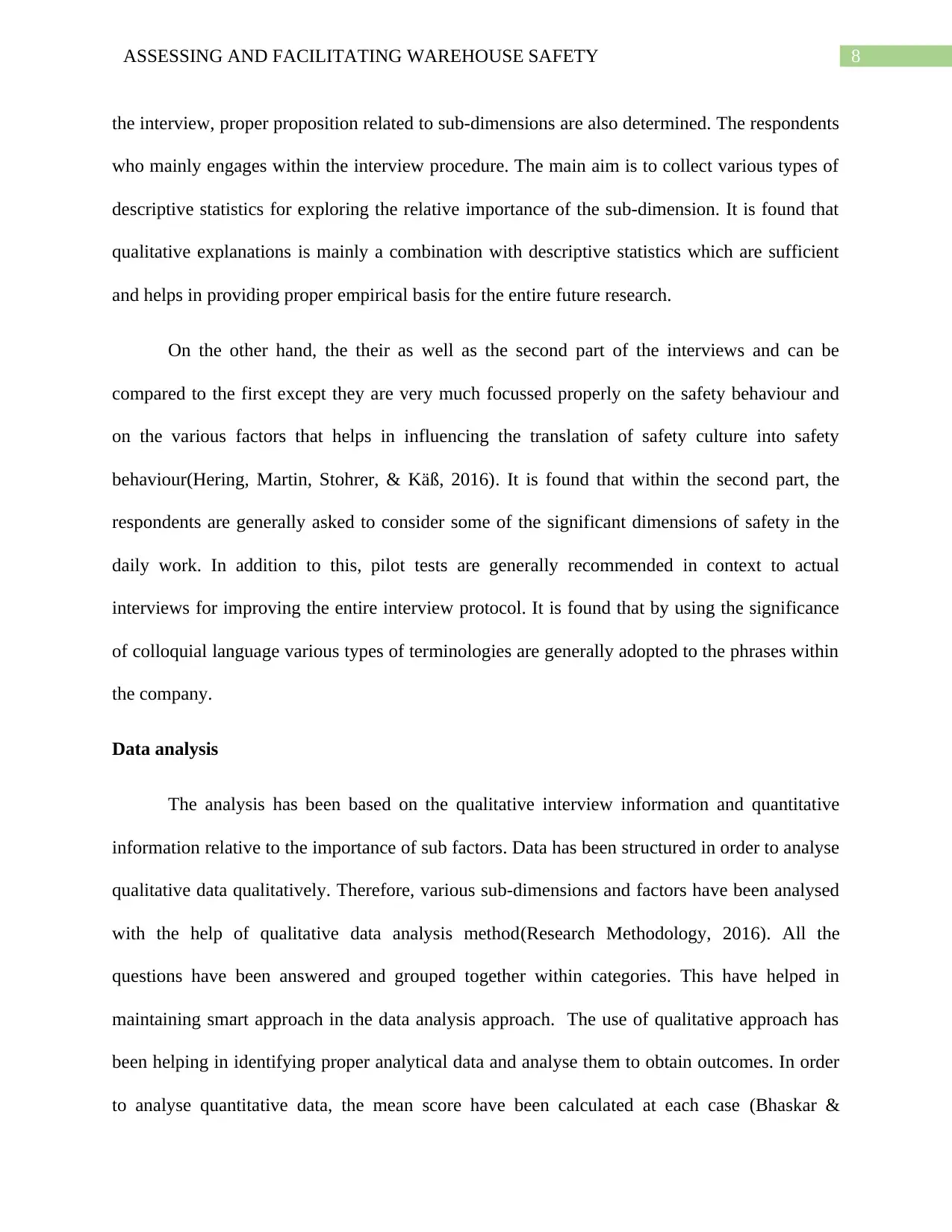
8ASSESSING AND FACILITATING WAREHOUSE SAFETY
the interview, proper proposition related to sub-dimensions are also determined. The respondents
who mainly engages within the interview procedure. The main aim is to collect various types of
descriptive statistics for exploring the relative importance of the sub-dimension. It is found that
qualitative explanations is mainly a combination with descriptive statistics which are sufficient
and helps in providing proper empirical basis for the entire future research.
On the other hand, the their as well as the second part of the interviews and can be
compared to the first except they are very much focussed properly on the safety behaviour and
on the various factors that helps in influencing the translation of safety culture into safety
behaviour(Hering, Martin, Stohrer, & Käß, 2016). It is found that within the second part, the
respondents are generally asked to consider some of the significant dimensions of safety in the
daily work. In addition to this, pilot tests are generally recommended in context to actual
interviews for improving the entire interview protocol. It is found that by using the significance
of colloquial language various types of terminologies are generally adopted to the phrases within
the company.
Data analysis
The analysis has been based on the qualitative interview information and quantitative
information relative to the importance of sub factors. Data has been structured in order to analyse
qualitative data qualitatively. Therefore, various sub-dimensions and factors have been analysed
with the help of qualitative data analysis method(Research Methodology, 2016). All the
questions have been answered and grouped together within categories. This have helped in
maintaining smart approach in the data analysis approach. The use of qualitative approach has
been helping in identifying proper analytical data and analyse them to obtain outcomes. In order
to analyse quantitative data, the mean score have been calculated at each case (Bhaskar &
the interview, proper proposition related to sub-dimensions are also determined. The respondents
who mainly engages within the interview procedure. The main aim is to collect various types of
descriptive statistics for exploring the relative importance of the sub-dimension. It is found that
qualitative explanations is mainly a combination with descriptive statistics which are sufficient
and helps in providing proper empirical basis for the entire future research.
On the other hand, the their as well as the second part of the interviews and can be
compared to the first except they are very much focussed properly on the safety behaviour and
on the various factors that helps in influencing the translation of safety culture into safety
behaviour(Hering, Martin, Stohrer, & Käß, 2016). It is found that within the second part, the
respondents are generally asked to consider some of the significant dimensions of safety in the
daily work. In addition to this, pilot tests are generally recommended in context to actual
interviews for improving the entire interview protocol. It is found that by using the significance
of colloquial language various types of terminologies are generally adopted to the phrases within
the company.
Data analysis
The analysis has been based on the qualitative interview information and quantitative
information relative to the importance of sub factors. Data has been structured in order to analyse
qualitative data qualitatively. Therefore, various sub-dimensions and factors have been analysed
with the help of qualitative data analysis method(Research Methodology, 2016). All the
questions have been answered and grouped together within categories. This have helped in
maintaining smart approach in the data analysis approach. The use of qualitative approach has
been helping in identifying proper analytical data and analyse them to obtain outcomes. In order
to analyse quantitative data, the mean score have been calculated at each case (Bhaskar &
⊘ This is a preview!⊘
Do you want full access?
Subscribe today to unlock all pages.

Trusted by 1+ million students worldwide
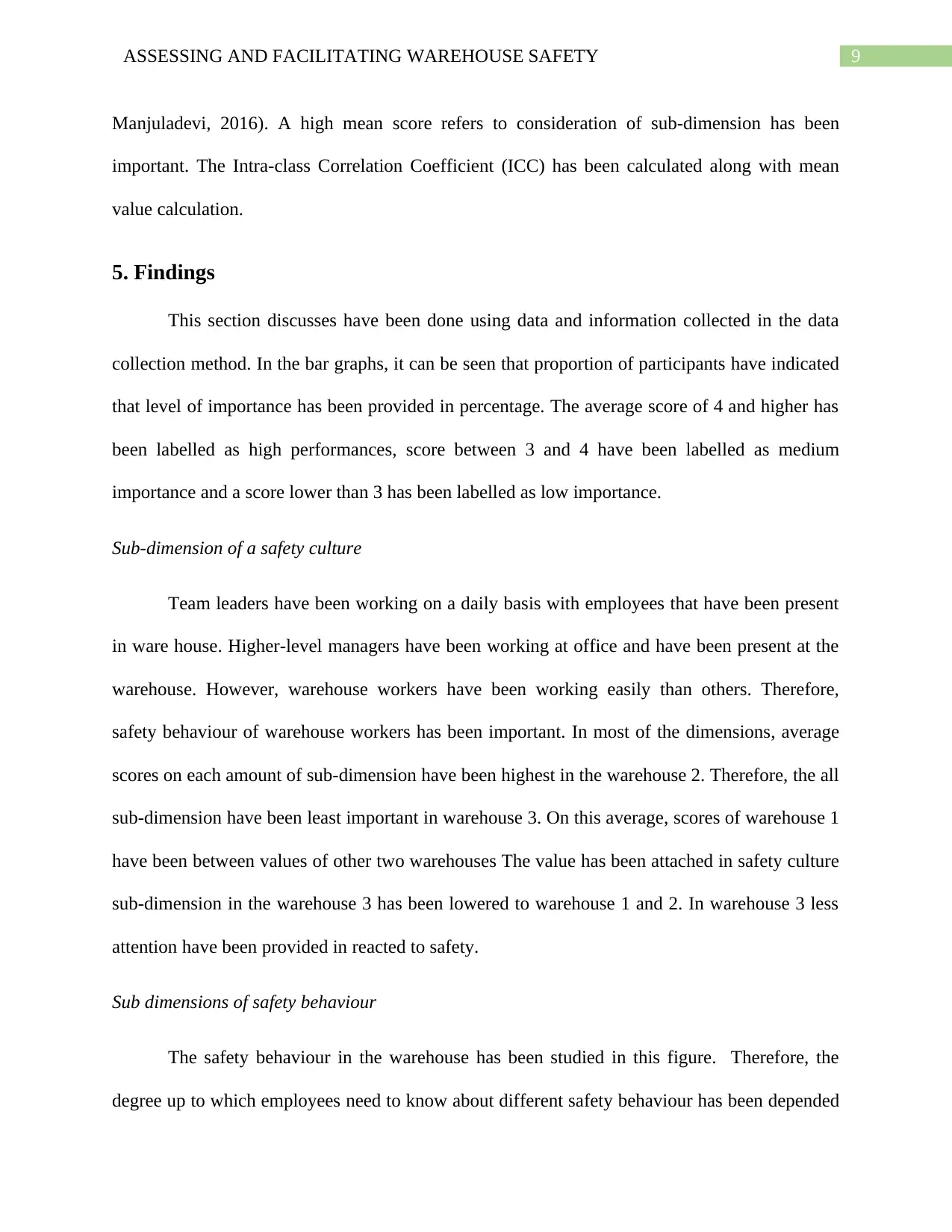
9ASSESSING AND FACILITATING WAREHOUSE SAFETY
Manjuladevi, 2016). A high mean score refers to consideration of sub-dimension has been
important. The Intra-class Correlation Coefficient (ICC) has been calculated along with mean
value calculation.
5. Findings
This section discusses have been done using data and information collected in the data
collection method. In the bar graphs, it can be seen that proportion of participants have indicated
that level of importance has been provided in percentage. The average score of 4 and higher has
been labelled as high performances, score between 3 and 4 have been labelled as medium
importance and a score lower than 3 has been labelled as low importance.
Sub-dimension of a safety culture
Team leaders have been working on a daily basis with employees that have been present
in ware house. Higher-level managers have been working at office and have been present at the
warehouse. However, warehouse workers have been working easily than others. Therefore,
safety behaviour of warehouse workers has been important. In most of the dimensions, average
scores on each amount of sub-dimension have been highest in the warehouse 2. Therefore, the all
sub-dimension have been least important in warehouse 3. On this average, scores of warehouse 1
have been between values of other two warehouses The value has been attached in safety culture
sub-dimension in the warehouse 3 has been lowered to warehouse 1 and 2. In warehouse 3 less
attention have been provided in reacted to safety.
Sub dimensions of safety behaviour
The safety behaviour in the warehouse has been studied in this figure. Therefore, the
degree up to which employees need to know about different safety behaviour has been depended
Manjuladevi, 2016). A high mean score refers to consideration of sub-dimension has been
important. The Intra-class Correlation Coefficient (ICC) has been calculated along with mean
value calculation.
5. Findings
This section discusses have been done using data and information collected in the data
collection method. In the bar graphs, it can be seen that proportion of participants have indicated
that level of importance has been provided in percentage. The average score of 4 and higher has
been labelled as high performances, score between 3 and 4 have been labelled as medium
importance and a score lower than 3 has been labelled as low importance.
Sub-dimension of a safety culture
Team leaders have been working on a daily basis with employees that have been present
in ware house. Higher-level managers have been working at office and have been present at the
warehouse. However, warehouse workers have been working easily than others. Therefore,
safety behaviour of warehouse workers has been important. In most of the dimensions, average
scores on each amount of sub-dimension have been highest in the warehouse 2. Therefore, the all
sub-dimension have been least important in warehouse 3. On this average, scores of warehouse 1
have been between values of other two warehouses The value has been attached in safety culture
sub-dimension in the warehouse 3 has been lowered to warehouse 1 and 2. In warehouse 3 less
attention have been provided in reacted to safety.
Sub dimensions of safety behaviour
The safety behaviour in the warehouse has been studied in this figure. Therefore, the
degree up to which employees need to know about different safety behaviour has been depended
Paraphrase This Document
Need a fresh take? Get an instant paraphrase of this document with our AI Paraphraser
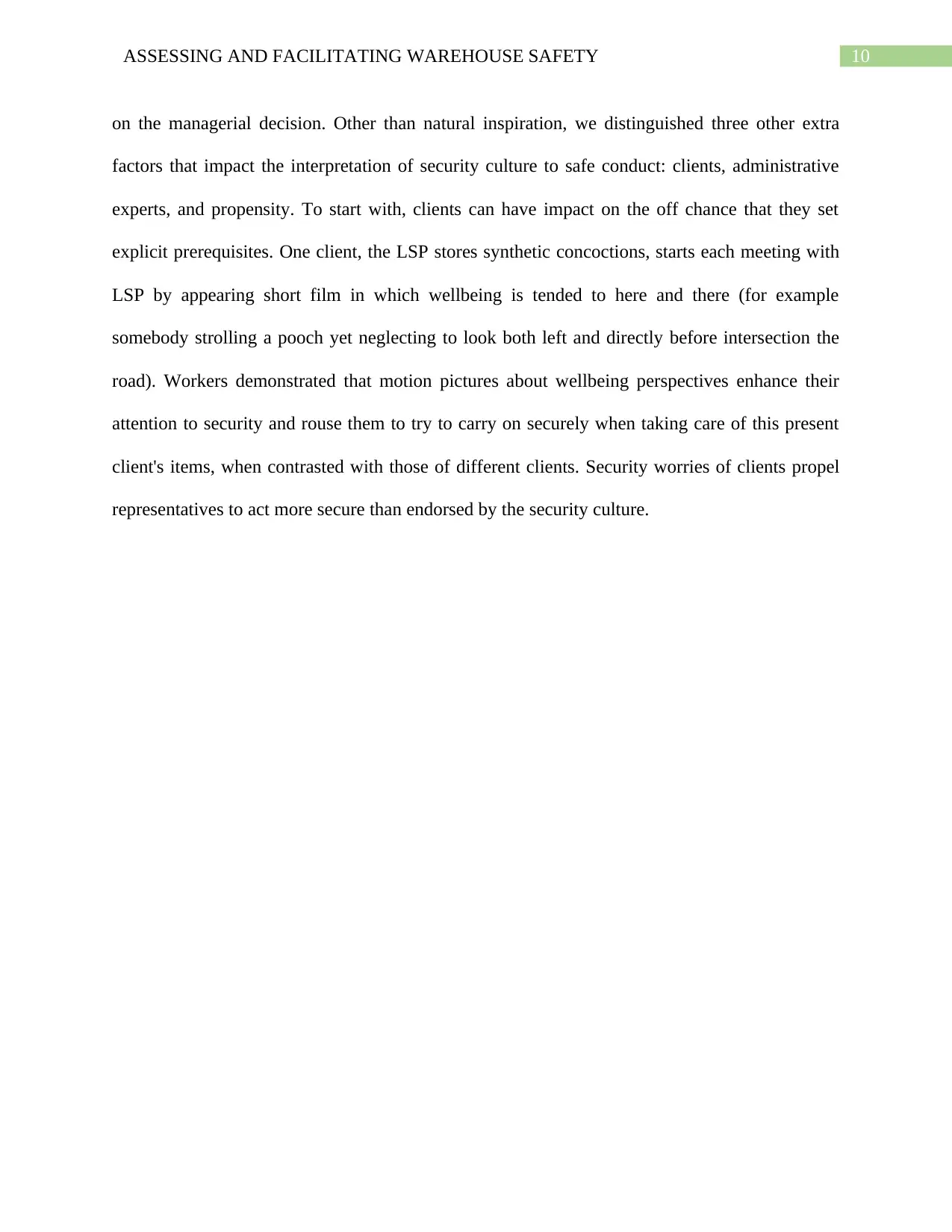
10ASSESSING AND FACILITATING WAREHOUSE SAFETY
on the managerial decision. Other than natural inspiration, we distinguished three other extra
factors that impact the interpretation of security culture to safe conduct: clients, administrative
experts, and propensity. To start with, clients can have impact on the off chance that they set
explicit prerequisites. One client, the LSP stores synthetic concoctions, starts each meeting with
LSP by appearing short film in which wellbeing is tended to here and there (for example
somebody strolling a pooch yet neglecting to look both left and directly before intersection the
road). Workers demonstrated that motion pictures about wellbeing perspectives enhance their
attention to security and rouse them to try to carry on securely when taking care of this present
client's items, when contrasted with those of different clients. Security worries of clients propel
representatives to act more secure than endorsed by the security culture.
on the managerial decision. Other than natural inspiration, we distinguished three other extra
factors that impact the interpretation of security culture to safe conduct: clients, administrative
experts, and propensity. To start with, clients can have impact on the off chance that they set
explicit prerequisites. One client, the LSP stores synthetic concoctions, starts each meeting with
LSP by appearing short film in which wellbeing is tended to here and there (for example
somebody strolling a pooch yet neglecting to look both left and directly before intersection the
road). Workers demonstrated that motion pictures about wellbeing perspectives enhance their
attention to security and rouse them to try to carry on securely when taking care of this present
client's items, when contrasted with those of different clients. Security worries of clients propel
representatives to act more secure than endorsed by the security culture.
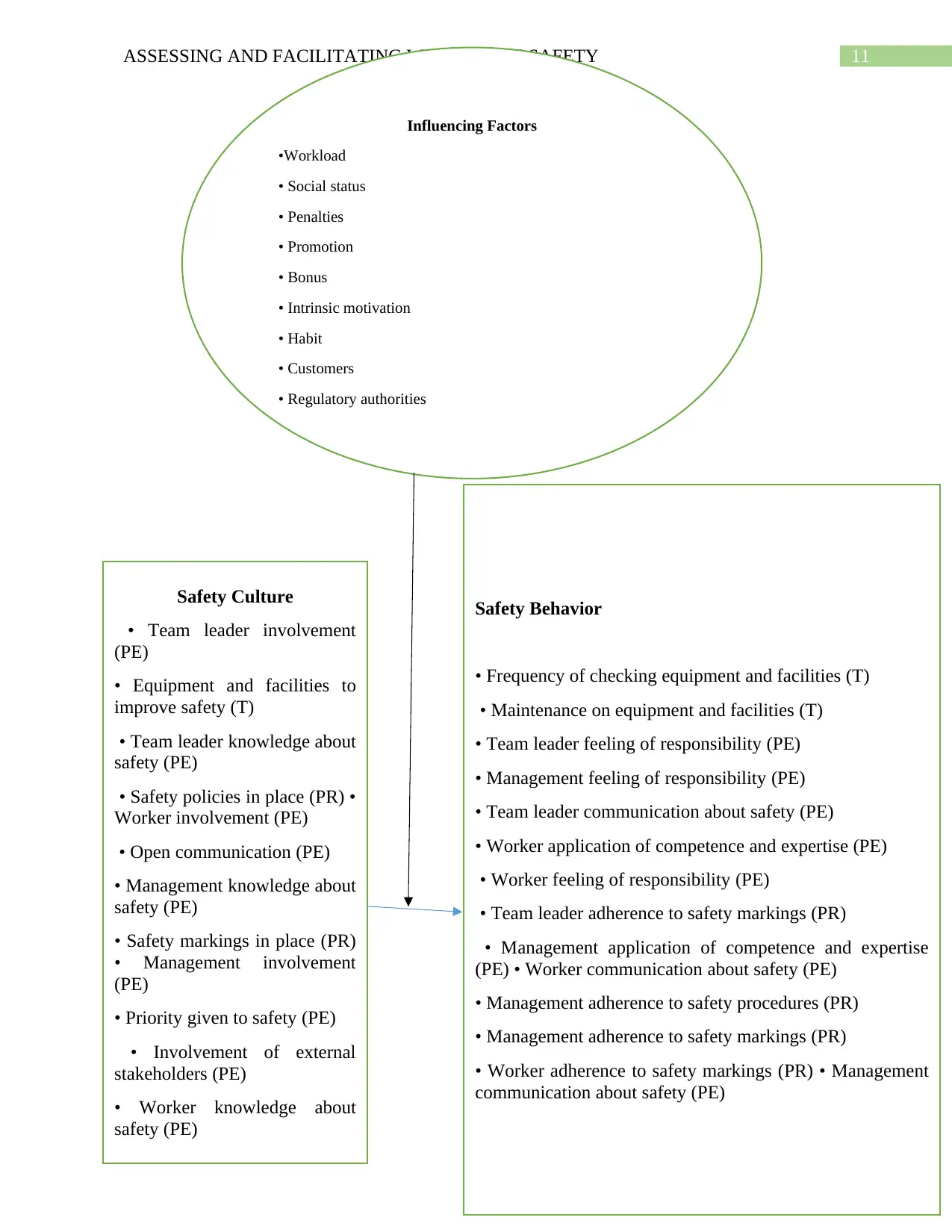
11ASSESSING AND FACILITATING WAREHOUSE SAFETY
Influencing Factors
•Workload
• Social status
• Penalties
• Promotion
• Bonus
• Intrinsic motivation
• Habit
• Customers
• Regulatory authorities
Safety Culture
• Team leader involvement
(PE)
• Equipment and facilities to
improve safety (T)
• Team leader knowledge about
safety (PE)
• Safety policies in place (PR) •
Worker involvement (PE)
• Open communication (PE)
• Management knowledge about
safety (PE)
• Safety markings in place (PR)
• Management involvement
(PE)
• Priority given to safety (PE)
• Involvement of external
stakeholders (PE)
• Worker knowledge about
safety (PE)
Safety Behavior
• Frequency of checking equipment and facilities (T)
• Maintenance on equipment and facilities (T)
• Team leader feeling of responsibility (PE)
• Management feeling of responsibility (PE)
• Team leader communication about safety (PE)
• Worker application of competence and expertise (PE)
• Worker feeling of responsibility (PE)
• Team leader adherence to safety markings (PR)
• Management application of competence and expertise
(PE) • Worker communication about safety (PE)
• Management adherence to safety procedures (PR)
• Management adherence to safety markings (PR)
• Worker adherence to safety markings (PR) • Management
communication about safety (PE)
Influencing Factors
•Workload
• Social status
• Penalties
• Promotion
• Bonus
• Intrinsic motivation
• Habit
• Customers
• Regulatory authorities
Safety Culture
• Team leader involvement
(PE)
• Equipment and facilities to
improve safety (T)
• Team leader knowledge about
safety (PE)
• Safety policies in place (PR) •
Worker involvement (PE)
• Open communication (PE)
• Management knowledge about
safety (PE)
• Safety markings in place (PR)
• Management involvement
(PE)
• Priority given to safety (PE)
• Involvement of external
stakeholders (PE)
• Worker knowledge about
safety (PE)
Safety Behavior
• Frequency of checking equipment and facilities (T)
• Maintenance on equipment and facilities (T)
• Team leader feeling of responsibility (PE)
• Management feeling of responsibility (PE)
• Team leader communication about safety (PE)
• Worker application of competence and expertise (PE)
• Worker feeling of responsibility (PE)
• Team leader adherence to safety markings (PR)
• Management application of competence and expertise
(PE) • Worker communication about safety (PE)
• Management adherence to safety procedures (PR)
• Management adherence to safety markings (PR)
• Worker adherence to safety markings (PR) • Management
communication about safety (PE)
⊘ This is a preview!⊘
Do you want full access?
Subscribe today to unlock all pages.

Trusted by 1+ million students worldwide
1 out of 17
Related Documents
Your All-in-One AI-Powered Toolkit for Academic Success.
+13062052269
info@desklib.com
Available 24*7 on WhatsApp / Email
![[object Object]](/_next/static/media/star-bottom.7253800d.svg)
Unlock your academic potential
Copyright © 2020–2025 A2Z Services. All Rights Reserved. Developed and managed by ZUCOL.





